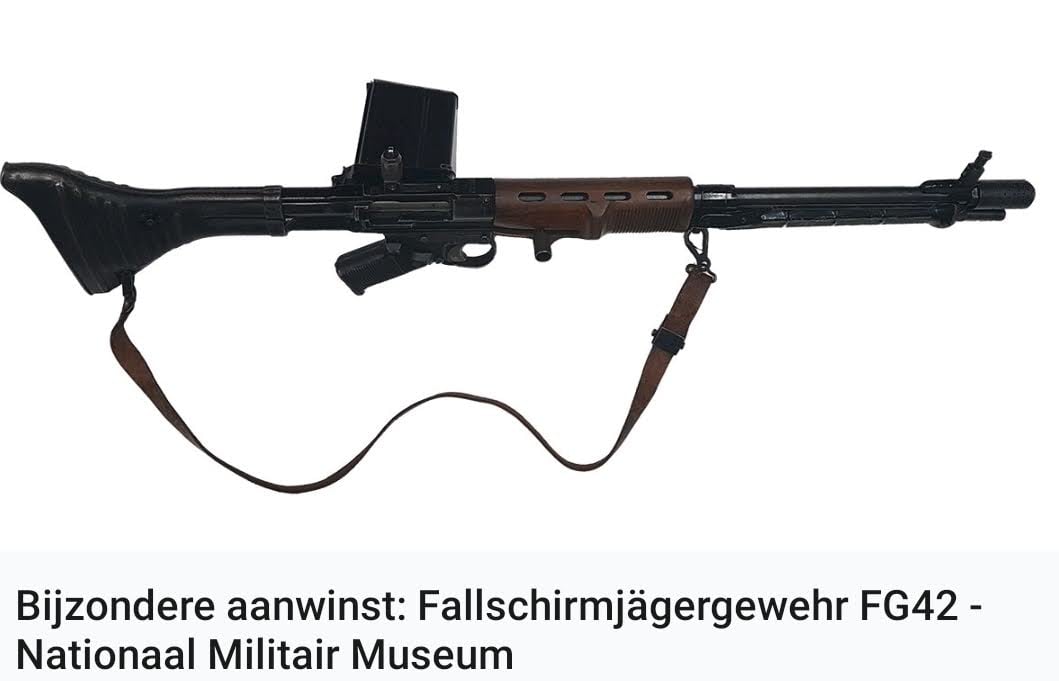
Recently, the Dutch National Military Museum in Soesterberg acquired an extremely rare FG42 Fallschirmjägergewehr from a confiscated illegal collection. Ever since I was a kid, I have been fascinated by German high-tech innovative weapons that were developed during the Second World War. Quite apart from the circumstances surrounding their inventions, the development of those weapons shows an unprecedented explosion of creativity and craftsmanship. The sheer number of innovative systems and their post-war impact in particular -can hardly be overestimated. This is by no means limited to Wernher von Braun’s well-known rocket technology that took us to the moon. All in all, the sheer number of the types of extreme rocket aircraft is beyond belief. A must for the enthusiast is a fascinating little museum in a backyard hangar at the huge Berlin-Gatow military airfield complex where they are all on display. Restored with German gründlichkeit (‘meticulousness’) obviously, although that is beside the point.
Not to be sniffed at
The type XXI electric submarine, of which the only remaining example can be marveled at in Bremerhafen, is also not to be sniffed at. Never put into service, but so far ahead of its time that until deep into the 20th century the submarine technology of the modern western navy was modeled on it. Moreover, the Sturmgewehr (‘assault weapon’ in German) – of which its name is unadulterated branding as is customary in these cases, must not go unmentioned. The Schmeisser, as it was originally called after its designer, is the very first mass-produced assault rifle. The Kalashnikov / AK47, which was copied from the Schmeisser and probably sounds much more familiar to you, arrived much later, as the number 47 implies.
In retrospect, one can safely draw the following conclusions about all these innovations: They were not enough and they took too long to get up and running. Efforts were far too fragmented, the resulting products mostly too complex, and there were not enough available resources nor enough manufacturing capacity to turn the odds of war around. This analysis sometimes reminds me of how things are going now in the industrialization of the construction sector. The case study of the invention of the FG42 paratrooper rifle seems an appropriate way to illustrate this.
High numbers of casualties
After an arbitrary attack by the Luftwaffe on Crete, which ended with very high casualties amongst the paratroopers, the army unit decided to develop a new rifle that a paratrooper could carry when they jumped. The German parachute system in use at the time required that the paratrooper land on his knees and then do a forward roll. This made it impossible to carry large or heavy weapons. So German paratroopers jumped, armed only with a pistol and a few hand grenades. Before going into combat, once they had landed, they first had to search for their weapons which had been dropped in containers. This all proved to be a bit awkward in practice.
Do you see the analogy? A whole chain is not work working. A system is not working. But none of that is being addressed. No, the solution is sought in the development of a new product on their own. An impressive product, it must be said.
Competition prize
So how did the most innovative rifle of WWII come about? Well, simply by holding a competition with a list of requirements that was asking the impossible. Why does that ring a bell? The funny thing is, that’s what the techies can do too, of course. On the one hand, by interpreting the rules creatively, but above all, by applying their cutting-edge craft. Oh yes, it turned out that the winning factory unfortunately had no manufacturing capacity. It also used too many scarce raw materials, production was time-consuming and subsequent models were not (backwards-)compatible.
The rifle really is rare.
But not a gamechanger.
About this column
In a weekly column, written alternately by Wendy van Ierschot, Eveline van Zeeland, Eugène Franken, Jan Wouters, Katleen Gabriels, Bert Overlack, Mary Fiers and Hans Helsloot, Innovation Origins tries to figure out what the future will look like. These columnists, occasionally joined by guest bloggers, are all working in their own way on solutions to the problems of our time. So that tomorrow is good. Here are all the previous articles.

